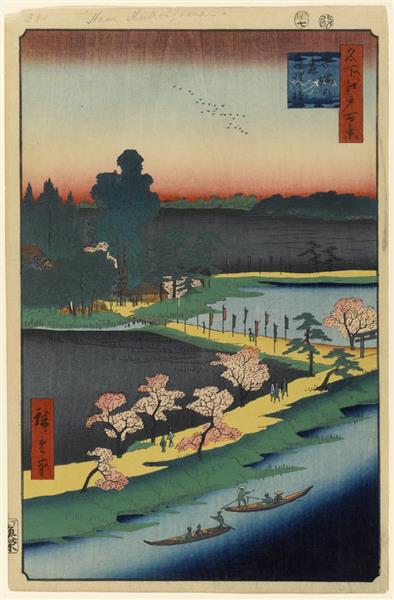Description
The work "31. Sanctuary Azuma No Mori and the Intertwined Camphor" (1857) by Utagawa Hiroshige is a brilliant example of the ukiyo-e style, which flourished in Japan during the Edo period. Throughout his career, Hiroshige stood out for his landscapes, capturing the essence of nature and everyday life with poetic sensitivity. This painting, part of his series "Fifty-Three Stations of Tōkaidō," is no exception and reveals a deep understanding of the atmosphere and the spiritual connection between man and the environment.
In the painting, the representation of a Japanese landscape becomes evident through the composition articulated in three distinct planes. In the foreground, the majestic intertwined camphor tree, which seems to come to life, rises like a guardian of the sanctuary. This tree, notable for its intertwined shape, symbolizes life, wisdom, and the interrelationship between living entities. Hiroshige has used an almost sculptural approach to this element, enhancing its three-dimensionality and providing a sense of solidity and permanence against the more ethereal background.
The sanctuary in the background is represented with refined detail that evokes an atmosphere of reverence. The sloping roofs and stylized architectural elements convey Japanese cultural heritage. Soft shadows and subtle hues have been employed to bring the structure to life, suggesting its sacred position in the landscape. The sky merges with shades of blue and violet that add depth to the scene, while touches of sky blue and pink, coming from the clouds, suggest the imminence of a sunset or sunrise.
As for the characters, although the work is predominantly focused on the landscape, a slight hint of human activity is perceived in the presence of tiny figures moving near the sanctuary. These characters provide a sense of scale, emphasizing the majesty of the natural environment and the architecture. Their gestures and movements, though subtle, establish a dialogue between the human and the sacred.
The color palette is characteristic of Hiroshige's style. The combination of vibrant and soft tones not only creates a visual balance but also evokes an atmosphere of peace and serenity. The woodblock printing techniques that allowed Hiroshige to layer colors and shades are visible in the fluid use of tonal transitions, resulting in a sense of harmony and simplicity.
In terms of historical context, this work is situated in a period when travel and tourism began to flourish in Japan. Hiroshige, through his representations of the Tōkaidō road—the main route connecting Edo (Tokyo) with Kyoto—not only offered beautiful views but also documented the changing landscape and culture of Japan in his time. "Sanctuary Azuma No Mori" encapsulates not only the beauty of the natural environment but also the reverence for spirituality and history that characterizes Hiroshige's vision.
In conclusion, "31. Azuma No Mori Sanctuary and the Intertwined Camphor" is a work that transcends its simple representation. It is a celebration of nature, a reminder of the connection between humans and their environment, and a reflection on the ephemeral beauty of life. Through his mastery in the use of color, composition, and the subtle representation of characters, Utagawa Hiroshige establishes himself as an master indisputable figure in Japanese art, and this work is a lasting testament to his genius.
KUADROS ©, a famous painting on your wall.
Hand-made oil painting reproductions, with the quality of professional artists and the distinctive seal of KUADROS ©.
Reproduction service of paintings with a satisfaction guarantee. If you are not completely satisfied with the replica of your painting, we will refund 100% of your money.

